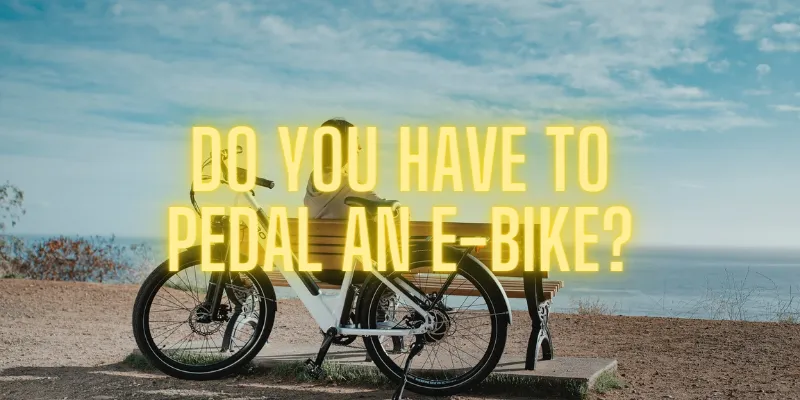Ebikes have steadily been gaining popularity amongst bike lovers because they require less work from their users than regular bikes. An e-bike’s ease of use coupled with its versatility is guaranteed to amp up your riding fun!
In some of the previous blog posts, I addressed various aspects of e-biking and electric bikes. So, you already know that it is faster, easier to ride and gives you a solid boost when conquering the trails…but do you have to pedal an electric bike?
In this article, I’ll be providing the answer to that question. You’ll also get the deets on the different types of electric bikes.
Do you still have to pedal an electric bike?
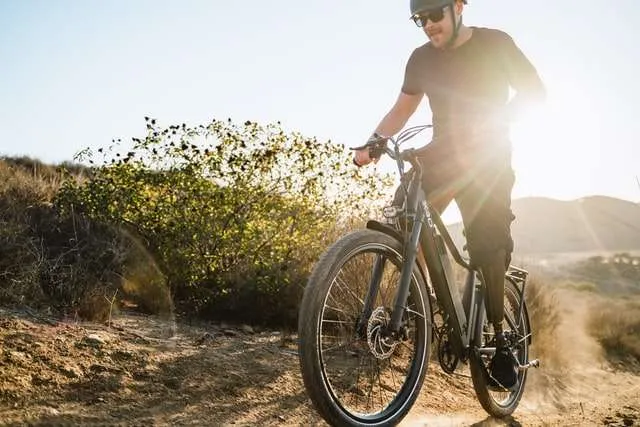
First of all, for a bicycle to be classified as an electric bike, it has to be equipped with a battery powered electric motor that helps you propel the bike. This means that the two key components of an ebike are the motor and the battery.
According to U.S federal law, the motor of a bicycle must have a maximum speed of 20mph for it to be considered an ebike. This law only specifies the maximum limit that an ebike can travel using just the motor power. However, it does not stipulate a maximum speed for a bike that’s propelled by a combo of human and motor power.
We have two classifications of bikes:
- Pedal assist
- Throttle only.
The pedal assist bike which is also referred to as pedelec operates in a mode that provides power only when you are pedaling. On the other hand, the throttle-only bike’s mode is similar to how a motorcycle or scooter operates. When the throttle is engaged, the motor provides power and propels you and the bike forward.

Now that it’s been established that an electric bike uses a battery powered motor to propel, it begs the question: Do you still have to pedal an electric bike?
To answer this question, I’ll tell you a story about my first encounter with an electric bike. At that time, I was just developing an interest in cycling and knew absolutely nothing about ebikes. One day, I borrowed a friend’s e-bike and took it for a spin. I was super excited to ride the throttle-only (Type 2) bike and didn’t ask for specific instructions.
I was simply excited to ride something much easier than my good old traditional bike. Unknown to me, relying totally on the throttle for a long ride is not a good idea. So I rode full throttle for half of my journey until the battery ran down and could no longer power the bike. Later on, after being rescued, my friend gave me a lecture about riding full throttle for only short distances. He also drilled into my head that an ebike’s motor is meant to aid human power, not replace it.
There lies your answer. Yes, for most ebikes, you do have to pedal an electric bike. However, this depends on the type of bike and the distance of your travel. A pedal assist bike requires that you pedal to get extra boost from the motor. But for the throttle-only bike, you only have to engage the throttle to accelerate and you may not have to pedal IF you’re only riding a short distance.
Types of Electric Bikes

According to Bosch, the three classes of bikes are:
- Class 1: eBikes that are pedal-assist only, with no throttle, and have a maximum assisted speed of 20 mph. This kind of bicycle is equipped with a motor that provides assistance only when you pedal. When the bike reaches its maximum speed of 20mph, the motor ceases to provide assistance for your pedaling.
- Class 2: This kind of e-bike is throttle assisted. The motor is controlled by a throttle and you only need to crank the throttle for acceleration. However, the less you pedal, the more power it uses, making you run out of battery juice to propel your bike. The throttle can be used exclusively to propel the bike but when it reaches the maximum speed of 20mph, it stops.
- Class 3: eBikes that are pedal-assist only, just like the class 1 bikes. It is the fastest class with a maximum assisted speed of 28 mph and no throttle. When you’re riding and the bike speeds up to 28mph, it stops assisting but you can continue pedaling.
All of these classes limit the motor’s power to 1 horsepower (750W).
Similarly, the U.S has a three-tiered e-bike classification system. The diagram below, fetched from ncsl.org, shows the states that have a definition for an ebike in their laws plus the classification of e-bikes across the country.
From the image above, twenty-six states have a three-tiered e-bike classification system that differentiates between models with varying speed capabilities and the remaining states do not.
However, New Jersey and West Virginia both established a two-tiered classification system. For New Jersey, the definition includes only the first two tiers of classification (Class 1 and 2). The legislature of the states then modified its definition of motorized bicycles to be one that “operates in excess of 20 MPH with a maximum motor-powered speed of 28 MPH.” This definition meets that of a “class three” e-bike.
In West Virginia, the law provides for “class one” and “class three” e-bikes, but not the “class two” (throttle-only) e-bike that can be propelled solely by a motor up to 20 MPH. This information is important to let you know the stance of your state regarding e-bikes and their classifications.
Now that you know the classes of e-bikes as 1, 2 and 3, they can be further classified under pedal assist and throttle only. I’ll explain.
Suggested post: How to charge your electric bike and improve its battery life
Pedal assist electric bikes
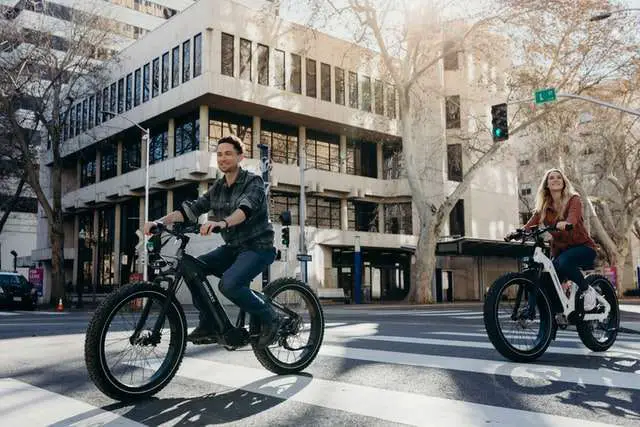
Pedal assist ebikes include the class 1 and 3 types. A pedal assist bike is powered when you crank the pedals. Pushing on the pedals helps you top-up electrical assistance. This means that you must pedal to activate the top-up power of the bike to boost your acceleration.
The torque of your pedal stroke is detected by a sensor which lets the bike give you additional support for acceleration. You’re also able to control the amount of assist that you need as most bikes have low, medium and high assist settings. The different power levels of assistance available on torque sensing pedelec can be low or high. It can be as little as 20% extra on top of your pedal effort or a whopping 100% of it.
At its highest, it’s amazing for climbing steep hills, getting you to work on time, etc. Additionally, on most pedelecs, you have the option of switching the power off and riding as you would on a traditional bike. Riding this way may be more difficult than normal. This is because the electric bike will be heavier and its motor usually adds a little extra pedal resistance, even when the pedal assist isn’t in use.
There are two types of pedal assist.
Torque Sensor Pedal Assist
The first one is called “torque sensor pedal assist.” This type of system measures the amount of power you are using to pedal the bike. It automatically increases or decreases the amount of assist based on your pedaling.
This means that the electric bike’s motor will increase its output relative to the amount of pedal force applied as you ride. Simply put, the harder you pedal, the more assistance you get. The less you pedal, the less assistance you get.
Cadence Sensor Pedal Assist
The second type is called the “cadence sensor pedal assist.” This type of assist does not increase or decrease the assist based on the amount of effort you are using on the pedal. The basic cadence sensor uses a magnet on the crank, turning the motor ON when you start pedaling and turning it OFF when you stop pedaling. The type of assist this gives only correlates with the level of assist you have selected. It is the less advanced of the two types of pedal assist.
Suggested article: How far do electric bikes go?
Throttle only electric bikes
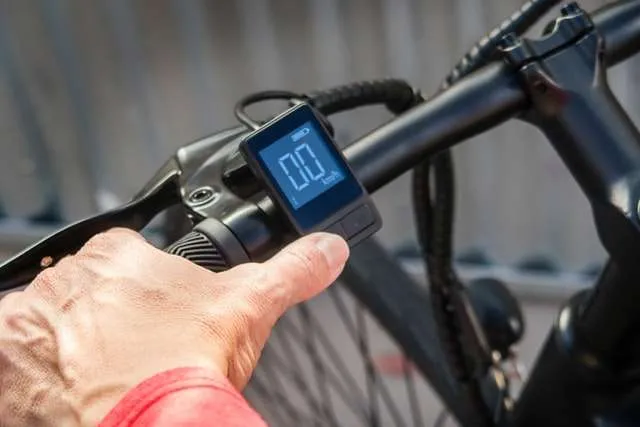
Throttle e-bikes are also described as low-speed throttle-assisted e-bikes. The electrical assist trails off to zero when it reaches its speed limit of 20mph. Beyond that speed limit, it can only be pedaled as a regular bike.
A throttle-only e-bike may or may not have pedal assist, but the presence of a throttle automatically puts it into the class 2 classification. With a throttle-only bike, you can propel by using the throttle assist.
There are about 3 types of throttle options for a throttle-only bike.
- The first type is the trigger/lever which is pushed with the finger for control.
- The second is the handlebar type that can be twisted to get the desired amount of power.
- And the third type of throttle has buttons that have a similar function of delivering full power.
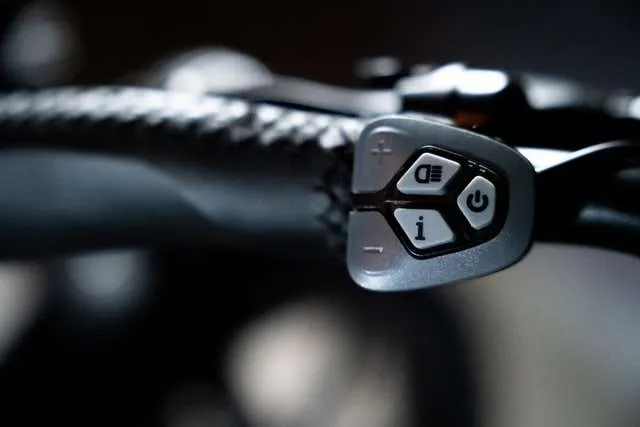
This last type often delivers full ‘all or nothing‘ power and overrides any power from the pedal-assist system that the bike may have. So, the method of activating the throttle depends on the model of your bike and the kind of throttle it features. Typically, the throttle connects to the electric bike’s system and helps you control your speed.
For an enjoyable ride, it is important to get an electric bike with good modulation. This refers to the smooth and gradual application of the throttle power such that it increases a little at a time. A bike’s throttle with poor modulation comes on quickly like a burst of power.
In the US, throttles that can operate entirely independently of the pedal system are legal and are found on class 2 and class 3 e-bikes. It is also possible that an e-bike may be described as both class 2 and class 3. This happens when the throttle powers the machine up to 20mph and from 20-28mph you can only use pedal assist.
Conclusion
So, whether you find throttle-only bikes invaluable or you prefer good quality pedal assist bikes, pedal! Although you may not need to pedal a throttle-only bike while riding, the more you rely on power without pedaling, the quicker you’ll run out of juice.
Always remember that the components are meant to augment human power not completely replace it. So I recommend that you only view the motor battery as an important assistant. If you do this, the combination of your pedaling and battery power will take you farther and faster.

